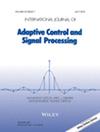Intelligent fault diagnosis of rolling bearings in strongly noisy environments using graph convolutional networks
IF 3.9
4区 计算机科学
Q2 AUTOMATION & CONTROL SYSTEMS
International Journal of Adaptive Control and Signal Processing
Pub Date : 2024-07-03
DOI:10.1002/acs.3869
引用次数: 0
Abstract
SummaryRolling bearings often function under complex and non‐stationary conditions, where significant noise interference complicates fault diagnosis by obscuring fault characteristics. This paper presents an innovative fault diagnosis technique using graph convolutional networks (GCN) to address these challenges. Vibration signals are first transformed into the frequency domain through fast Fourier transform (FFT), creating a detailed graph where nodes and edges encapsulate fault signals. The GCN method then extracts complex node features from this graph, enabling a classifier, comprising a fully connected layer and Softmax function, to accurately identify fault types. Experimental results demonstrate the superior performance of the proposed GCN‐based fault diagnosis method, achieving an accuracy of 99.79%. This significantly surpasses traditional machine learning methods (85.4%), deep learning models (92.3%), and other graph neural network approaches (94.1%). Notably, the method shows exceptional resilience to noise, maintaining high accuracy even with 20% added noise, underscoring its robustness for practical industrial applications. The transformation of vibration signals into the frequency domain using FFT, followed by constructing a detailed graph structure, enables the GCN to effectively capture and represent intricate fault characteristics, thus enhancing accurate fault classification. These findings highlight the method's practical applicability and potential for deployment in advanced industrial settings characterized by high noise levels and complexity.利用图卷积网络对强噪声环境中的滚动轴承进行智能故障诊断
摘要滚动轴承通常在复杂和非稳态条件下工作,大量噪声干扰掩盖了故障特征,使故障诊断变得复杂。本文利用图卷积网络(GCN)提出了一种创新的故障诊断技术,以应对这些挑战。首先通过快速傅立叶变换 (FFT) 将振动信号转换到频域,创建一个详细的图,其中的节点和边封装了故障信号。然后,GCN 方法从该图中提取复杂的节点特征,使由全连接层和 Softmax 函数组成的分类器能够准确识别故障类型。实验结果表明,基于 GCN 的故障诊断方法性能优越,准确率达到 99.79%。这大大超过了传统的机器学习方法(85.4%)、深度学习模型(92.3%)和其他图神经网络方法(94.1%)。值得注意的是,该方法对噪声表现出了卓越的适应能力,即使在噪声增加 20% 的情况下也能保持较高的准确率,这凸显了该方法在实际工业应用中的稳健性。利用 FFT 将振动信号转换到频域,然后构建详细的图结构,使 GCN 能够有效捕捉和表示复杂的故障特征,从而提高故障分类的准确性。这些发现凸显了该方法的实用性和在具有高噪声水平和复杂性特点的先进工业环境中部署的潜力。
本文章由计算机程序翻译,如有差异,请以英文原文为准。
求助全文
约1分钟内获得全文
求助全文
来源期刊
CiteScore
5.30
自引率
16.10%
发文量
163
审稿时长
5 months
期刊介绍:
The International Journal of Adaptive Control and Signal Processing is concerned with the design, synthesis and application of estimators or controllers where adaptive features are needed to cope with uncertainties.Papers on signal processing should also have some relevance to adaptive systems. The journal focus is on model based control design approaches rather than heuristic or rule based control design methods. All papers will be expected to include significant novel material.
Both the theory and application of adaptive systems and system identification are areas of interest. Papers on applications can include problems in the implementation of algorithms for real time signal processing and control. The stability, convergence, robustness and numerical aspects of adaptive algorithms are also suitable topics. The related subjects of controller tuning, filtering, networks and switching theory are also of interest. Principal areas to be addressed include:
Auto-Tuning, Self-Tuning and Model Reference Adaptive Controllers
Nonlinear, Robust and Intelligent Adaptive Controllers
Linear and Nonlinear Multivariable System Identification and Estimation
Identification of Linear Parameter Varying, Distributed and Hybrid Systems
Multiple Model Adaptive Control
Adaptive Signal processing Theory and Algorithms
Adaptation in Multi-Agent Systems
Condition Monitoring Systems
Fault Detection and Isolation Methods
Fault Detection and Isolation Methods
Fault-Tolerant Control (system supervision and diagnosis)
Learning Systems and Adaptive Modelling
Real Time Algorithms for Adaptive Signal Processing and Control
Adaptive Signal Processing and Control Applications
Adaptive Cloud Architectures and Networking
Adaptive Mechanisms for Internet of Things
Adaptive Sliding Mode Control.

 求助内容:
求助内容: 应助结果提醒方式:
应助结果提醒方式:


